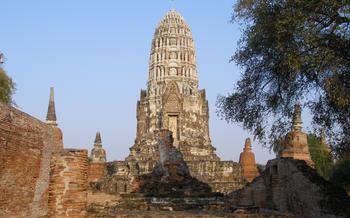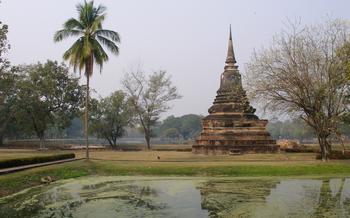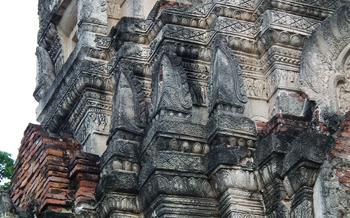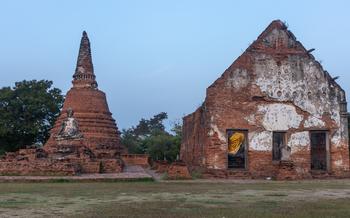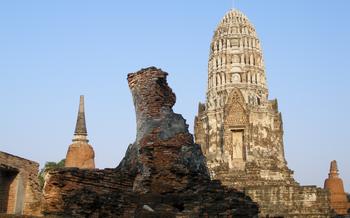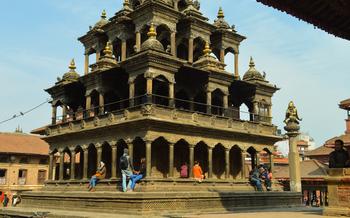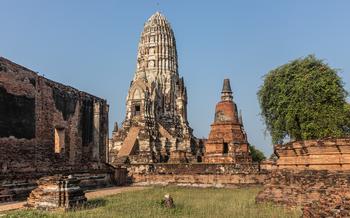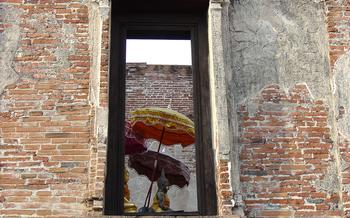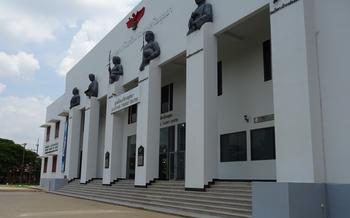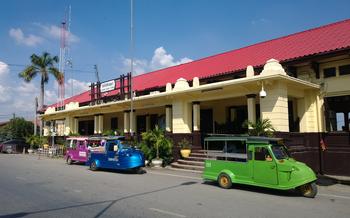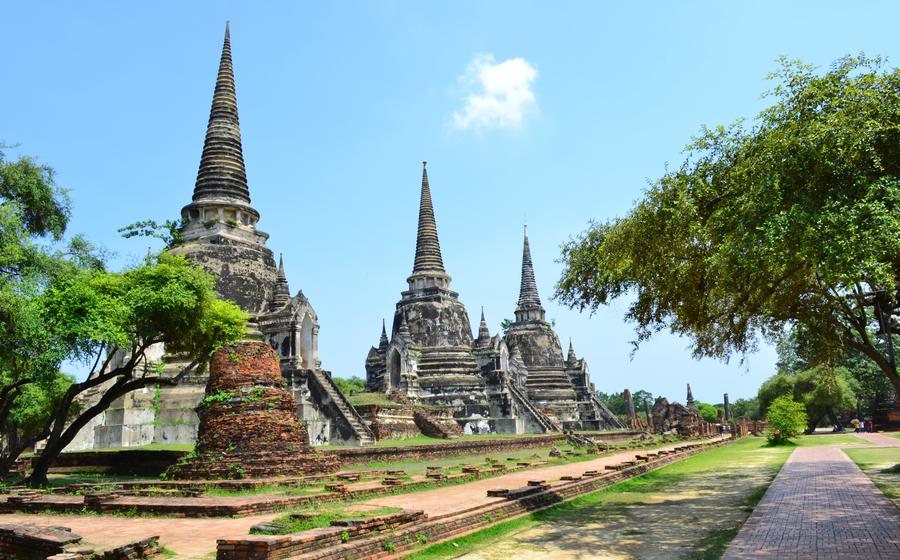
Wat Phra Sri Sanphet
- Wat Phra Sri Sanphet: A Historical Overview
- Exploring the Ruins of Wat Phra Sri Sanphet
- Admiring the Exquisite Stupas
- Understanding the Importance of the Buddha Images
- Paying Respect at the Sacred Bodhi Tree
- Wandering Through the Majestic Grounds
- Learning About the Ancient Monasteries
- Unraveling the Mysteries of the Palace Ruins
- Appreciating the Exquisite Murals
- Visiting the Nearby Wat Mahathat
- Exploring the Ayutthaya Historical Park
- Planning Your Visit to Wat Phra Sri Sanphet
- Finding Authentic Thai Cuisine
- Transportation Options to Wat Phra Sri Sanphet
- Insider Tip: Off-the-Beaten-Path Gems
Wat Phra Sri Sanphet: A Historical Overview
The majestic Wat Phra Sri Sanphet, nestled within the ancient city of Ayutthaya, stands as a testament to Thailand's rich history and cultural heritage. Built in the 14th century during the Ayutthaya Kingdom, this grand temple once served as the royal chapel and was the most important temple in the kingdom. Its name, meaning "Temple of the Holy, Splendid Victory," reflects the profound significance it held for the Thai people.
Wat Phra Sri Sanphet's architectural design epitomizes the grandeur and opulence of the Ayutthaya period. The temple complex features three towering prang, or spires, symbolizing the three worlds of Buddhism: heaven, earth, and hell. These prang, adorned with intricate carvings and colorful glazed tiles, rise majestically above the surrounding ruins, creating a breathtaking spectacle.
Throughout Thai history, Wat Phra Sri Sanphet played a pivotal role in religious ceremonies, royal coronations, and significant events. It was considered the spiritual center of the kingdom, where the royal family and high-ranking officials performed rituals and paid homage to the Buddha. The temple's hallowed grounds witnessed countless processions, festivals, and acts of devotion, solidifying its place as a sacred and revered site in Thai society.
Exploring the Ruins of Wat Phra Sri Sanphet
The ruins of Wat Phra Sri Sanphet are located within the Ayutthaya Historical Park, a UNESCO World Heritage Site that encompasses numerous ancient temples and palaces. The site offers a glimpse into the grandeur and splendor of Ayutthaya's past.
Amidst the lush vegetation and towering trees, visitors can explore the remnants of the once-magnificent temple complex. The ruins include the foundations of the main sanctuary, which was once adorned with intricate carvings and sculptures. The surrounding galleries and halls, now reduced to rubble, once housed hundreds of Buddha images and served as centers of religious devotion.
One of the most striking features of the temple ruins is the collection of stupas, or bell-shaped structures, that dot the landscape. These stupas, which vary in size and design, were built to enshrine the ashes of deceased monarchs and high-ranking officials. Their presence adds an air of solemnity and reverence to the site.
Admiring the Exquisite Stupas
At Wat Phra Sri Sanphet, the stupas stand as a testament to the architectural prowess and spiritual devotion of the Ayutthaya Kingdom. These majestic structures, also known as chedis, were built to house the ashes of the royal family and high-ranking monks. Each stupa is unique in its design and symbolism, reflecting the diverse artistic influences that shaped Ayutthaya's cultural heritage.
The most prominent stupa is the Phra Si Ratana Chedi, located at the center of the temple grounds. This massive stupa is adorned with intricate carvings and features a distinctive bell-shaped design. It is believed to contain the ashes of King Ramathibodi I, the founder of the Ayutthaya Kingdom.
Surrounding the Phra Si Ratana Chedi are four smaller stupas, each representing a different direction. These stupas are adorned with intricate stuccowork and feature various symbolic motifs, such as lotus flowers and mythical creatures. They are believed to contain the ashes of other members of the royal family and high-ranking monks.
The stupas at Wat Phra Sri Sanphet are not merely architectural masterpieces; they also hold deep religious significance. Buddhists believe that stupas represent the enlightened mind of the Buddha and serve as a reminder of his teachings. By paying respect to the stupas, visitors can connect with the spiritual essence of the temple and gain merit.
Understanding the Importance of the Buddha Images
Wat Phra Sri Sanphet is home to a remarkable collection of Buddha images, each possessing historical, cultural, and religious significance. These images, crafted with intricate detail and artistry, represent different periods of Thai history and embody the essence of Buddhist teachings.
The most prominent Buddha image is the Phra Buddha Sri Sanphet, a colossal bronze statue that once stood inside the main ordination hall. This magnificent image, measuring over 15 meters in height, was cast in the 15th century and is considered one of the finest examples of Thai Buddhist art. The statue exudes an aura of serenity and compassion, capturing the essence of the Buddha's teachings on peace, love, and enlightenment.
Other notable Buddha images include the Phra Buddha Lohan, a seated Buddha with a serene expression, and the Phra Buddha Traimit, a massive gold Buddha statue that was discovered hidden within a layer of stucco in 195These images, along with numerous other smaller Buddha statues scattered throughout the temple grounds, provide a glimpse into the rich Buddhist heritage of Thailand.
Beyond their artistic value, these Buddha images hold deep religious significance for Thai people. They are revered as sacred objects, representing the presence of the Buddha himself. Devotees often pay homage to the images, offering prayers, flowers, and incense as a symbol of their devotion and gratitude. The Buddha images serve as a reminder of the Buddha's teachings and inspire spiritual reflection among visitors.
Paying Respect at the Sacred Bodhi Tree
The sacred Bodhi tree, also known as the "Tree of Enlightenment," holds a significant place within the grounds of Wat Phra Sri Sanphet. Located in the northwestern corner of the temple compound, this revered tree is believed to have originated from the same lineage as the original Bodhi tree under which Lord Buddha attained enlightenment in Bodhgaya, India.
The Bodhi tree at Wat Phra Sri Sanphet is a symbol of peace, wisdom, and spiritual awakening. Devotees often visit the tree to pay their respects and offer prayers. They light incense sticks, make offerings of flowers and fruit, and perform rituals to seek blessings and guidance.
One of the unique rituals associated with the Bodhi tree is the "water pouring" ceremony. Visitors pour water over the roots of the tree as a symbolic act of purification and renewal. This ritual is believed to bring good luck, prosperity, and protection from harm.
The Bodhi tree is not only a religious symbol but also a reminder of the deep connection between Buddhism and nature. Its presence within the temple grounds serves as a reminder of the importance of finding inner peace and enlightenment through spiritual practices and contemplation.
Wandering Through the Majestic Grounds
As you explore the sprawling grounds of Wat Phra Sri Sanphet, you'll be captivated by its intricate layout and awe-inspiring structures. The temple's design follows the traditional Buddhist cosmology, with the central stupa representing Mount Meru, the sacred abode of the gods. Surrounding the stupa are a series of concentric walls and courtyards, each representing a different realm of existence.
Within the temple compound, you'll find numerous notable structures and features that showcase the architectural prowess of the Ayutthaya Kingdom. The wihan, or assembly hall, is a magnificent building with a soaring roof and intricate carvings. The bot, or ordination hall, is where monks received their ordination and performed religious ceremonies. The mondop, a square pavilion, was used for housing sacred relics and Buddha images.
The serene atmosphere and spiritual significance of Wat Phra Sri Sanphet make it a truly special place to visit. As you wander through the grounds, you'll feel a sense of peace and tranquility that is palpable. The temple's ancient ruins and sacred structures serve as a reminder of the enduring power of faith and the rich history of Thailand.
Learning About the Ancient Monasteries
Amidst the ruins of Wat Phra Sri Sanphet, the ancient monasteries stand as testaments to the religious devotion and community life that once thrived within the temple complex. These monasteries, once home to hundreds of monks, played a crucial role in the daily life of Ayutthaya.
The monasteries, constructed with intricate architectural styles, featured spacious halls for meditation and study, as well as living quarters for the monks. Explore these structures to gain insights into the monastic life that shaped the spiritual and cultural landscape of Ayutthaya.
The monasteries were not merely places of worship but also centers of learning and community. Monks dedicated themselves to studying Buddhist scriptures, practicing meditation, and providing guidance to the local population. Visitors can still sense the serene atmosphere that once permeated these sacred spaces.
Unraveling the Mysteries of the Palace Ruins
Amidst the sprawling ruins of Wat Phra Sri Sanphet, the remnants of the ancient royal palace stand as silent witnesses to the grandeur and power of the Ayutthaya Kingdom. Once a magnificent complex where kings held court, received foreign dignitaries, and conducted state affairs, the palace now lies in ruins, its former glory faded but its historical significance undiminished.
The palace ruins are located to the west of the temple's main complex, occupying a vast area that once housed numerous buildings, courtyards, and gardens. Visitors can explore the foundations of these structures, marveling at the intricate brickwork and the sheer scale of the complex.
While much of the palace has been reduced to rubble, some remnants still hint at its former splendor. The audience hall, where the king would receive visitors and officials, is still partially intact, with its grand entrance and towering pillars. Other notable features include the royal chambers, the throne hall, and the treasury, where the kingdom's wealth was once stored.
As you wander through the palace ruins, let your imagination transport you back in time to the days when Ayutthaya was at the height of its power. Picture the bustling courtyards, the lavish ceremonies, and the intricate political machinations that took place within these walls. The palace ruins are a poignant reminder of the kingdom's rise and fall, and a testament to the enduring legacy of Ayutthaya.
Appreciating the Exquisite Murals
Amidst the ruins of Wat Phra Sri Sanphet, visitors can marvel at the remnants of intricate murals that once adorned the temple walls. These murals, though faded and worn, offer a glimpse into the artistry and storytelling of the Ayutthaya period.
The murals depict scenes from Buddhist mythology, royal ceremonies, and everyday life in ancient Thailand. Through these vibrant paintings, visitors can gain insight into the beliefs, customs, and traditions of the Siamese kingdom. The murals are not only aesthetically pleasing but also serve as a window into the past, allowing visitors to connect with the history and culture of Ayutthaya.
One of the most famous murals is the "Procession of the Royal Barges," which depicts a grand procession of royal boats along the Chao Phraya River. The mural showcases the opulence and grandeur of the Ayutthaya court, with its elaborate barges, royal regalia, and colorful costumes.
Another notable mural is the "Battle of Yodhya," which portrays a fierce battle between the Siamese and Burmese armies. The mural captures the intensity of the conflict, with warriors engaged in hand-to-hand combat, elephants charging into battle, and the chaos of war unfolding on the canvas.
Exploring the murals of Wat Phra Sri Sanphet is a unique and immersive experience that allows visitors to appreciate the artistic achievements of the Ayutthaya era. These murals bring history to life and offer a deeper understanding of the culture and traditions of ancient Thailand.
Visiting the Nearby Wat Mahathat
A short walk from Wat Phra Sri Sanphet, you'll find another must-see attraction in Ayutthaya - the awe-inspiring Wat Mahathat. This ancient temple complex dates back to the 14th century and is renowned for its iconic Buddha head entwined by the roots of a bodhi tree. The serene countenance of the Buddha, partially obscured by the tree's embrace, has become a symbol of the enduring power of nature and the transience of human existence. Explore the ruins of Wat Mahathat and discover its captivating blend of history, spirituality, and natural beauty.
Exploring the Ayutthaya Historical Park
Beyond Wat Phra Sri Sanphet, the Ayutthaya Historical Park encompasses a treasure trove of ancient temples, ruins, and historical landmarks, each holding its unique story and significance. Explore the sprawling park and discover the remnants of Ayutthaya's glorious past.
-
Wat Mahathat: Renowned for its iconic Buddha head entwined by the roots of a banyan tree, Wat Mahathat is a must-see attraction within the park. Wander through the temple grounds and admire the intricate carvings and sculptures that adorn its structures.
-
Wat Ratchaburana: This temple features impressive prang towers and beautiful murals depicting scenes from the Ramayana epic. Its unique architecture and historical significance make it a popular spot for visitors.
-
Wat Chaiwatthanaram: Located on the west bank of the Chao Phraya River, this temple boasts a stunning setting and a distinctive Khmer-style architecture. Its towering prang towers and intricate carvings offer a glimpse into the artistic and religious influences of the past.
-
Wat Yai Chai Mongkhon: Known for its giant reclining Buddha image, Wat Yai Chai Mongkhon is a peaceful and serene temple. Visitors can admire the impressive size and serene expression of the Buddha, which exudes an aura of tranquility and devotion.
-
Elephant Kraal: Experience a unique piece of history at the Elephant Kraal, where elephants were once rounded up and trained for royal ceremonies and warfare. The massive stone enclosure and surrounding structures provide an insight into the important role elephants played in Ayutthaya's past.
Exploring the Ayutthaya Historical Park is a journey through time, allowing visitors to delve into the rich history and cultural heritage of this ancient kingdom. Each temple and ruin tells a unique tale, offering a glimpse into the grandeur and splendor of Ayutthaya's golden age.
Planning Your Visit to Wat Phra Sri Sanphet
To make the most of your visit to Wat Phra Sri Sanphet, careful planning is essential. The best time to visit the temple is during the cooler months from November to February when the weather is pleasant. It's advisable to arrive early in the morning to avoid the midday heat and the crowds that tend to gather later in the day.
When visiting the temple, appropriate attire is expected as a sign of respect for the sacred site. Shorts, tank tops, and revealing clothing are discouraged. Visitors are required to dress modestly, with covered shoulders and knees. There is a strict dress code enforced, so it's best to err on the side of caution and dress respectfully.
Entrance to Wat Phra Sri Sanphet is included in the ticket for the Ayutthaya Historical Park. The ticket costs 65 baht per person and can be purchased at the entrance to any of the temples within the park. The ticket grants access to all the temples and ruins within the park for a single day.
Finding Authentic Thai Cuisine
To fully immerse yourself in the cultural experience of visiting Wat Phra Sri Sanphet, don't miss out on the opportunity to savor authentic Thai cuisine. Ayutthaya is renowned for its culinary delights, offering a diverse range of dishes that tantalize the taste buds.
For an authentic Thai dining experience, head to one of the many local restaurants near the temple. Krua Thai Ayutthaya is a popular choice, serving up traditional Thai dishes with fresh ingredients and mouthwatering flavors. Their pad thai and green curry are must-try dishes.
Another highly recommended restaurant is Baan Yai Restaurant. This family-run establishment serves up home-style Thai cooking in a warm and friendly atmosphere. Their tom yum goon and massaman curry are particularly noteworthy.
If you're looking for a more casual dining experience, try one of the many street food stalls that line the streets of Ayutthaya. Here you'll find a variety of local delicacies, such as pad see ew, khao soi, and som tam. Don't be afraid to experiment and try something new!
Remember that when dining in Thailand, it's customary to share dishes among the table. This allows you to sample a variety of flavors and experience the communal aspect of Thai dining culture. Also, don't forget to try the local mango sticky rice for a sweet and satisfying dessert.
So, after exploring the ancient ruins of Wat Phra Sri Sanphet, be sure to embark on a culinary adventure and discover the delectable flavors of authentic Thai cuisine. Your taste buds will thank you!
Transportation Options to Wat Phra Sri Sanphet
Reaching Wat Phra Sri Sanphet is convenient from Bangkok and other cities in Thailand. Several transportation options are available, catering to different preferences and budgets.
From Bangkok, the most popular mode of transport is the train. Trains depart from Bangkok's Hualamphong Station and take approximately 1 hour and 30 minutes to reach Ayutthaya Station. Once in Ayutthaya, you can take a tuk-tuk or taxi to the temple, which is about a 10-minute ride away.
Another option from Bangkok is to take a bus. Buses depart from the Bangkok Southern Bus Terminal and take around 2 hours to reach Ayutthaya. From the bus station, you can take a tuk-tuk or taxi to the temple.
If you prefer a more private and flexible option, you can rent a car and drive to Ayutthaya. The drive takes about 1 hour and 30 minutes from Bangkok. Once in Ayutthaya, you can easily navigate to the temple using GPS or a map.
No matter your choice of transportation, getting to Wat Phra Sri Sanphet is straightforward and convenient. Embrace the journey as part of the adventure and soak in the charm of the Thai countryside along the way.
Insider Tip: Off-the-Beaten-Path Gems
Beyond the main tourist attractions, Ayutthaya offers a treasure trove of hidden gems waiting to be discovered. For those seeking a more immersive experience, venture off the beaten path to explore lesser-known temples and ruins that offer a glimpse into the city's rich history and culture. These hidden gems may not be as grand as the major temples, but they often exude a sense of tranquility and authenticity that is hard to find elsewhere.
One such hidden gem is Wat Ratchaburana, located a short distance from Wat Phra Sri Sanphet. This temple is known for its impressive prang (spire) and beautiful murals depicting scenes from the Ramayana epic. Another must-visit is Wat Chaiwatthanaram, situated on the banks of the Chao Phraya River. This temple is famous for its unique blend of Khmer and Thai architectural styles, featuring a central prang surrounded by smaller prangs.
To experience the authentic charm of Ayutthaya, be sure to explore the local markets. The Ayutthaya Floating Market, held on weekends, is a vibrant and colorful affair where you can find a variety of local delicacies, handicrafts, and souvenirs. The Bang Ian Market, on the other hand, is a more traditional market offering a glimpse into the daily lives of the local people.
Exploring the off-the-beaten-path gems of Ayutthaya is a rewarding experience that allows you to delve deeper into the city's history and culture. These hidden treasures offer a unique perspective on Ayutthaya's rich heritage, providing a glimpse into the lives of its people and the grandeur of its past.
